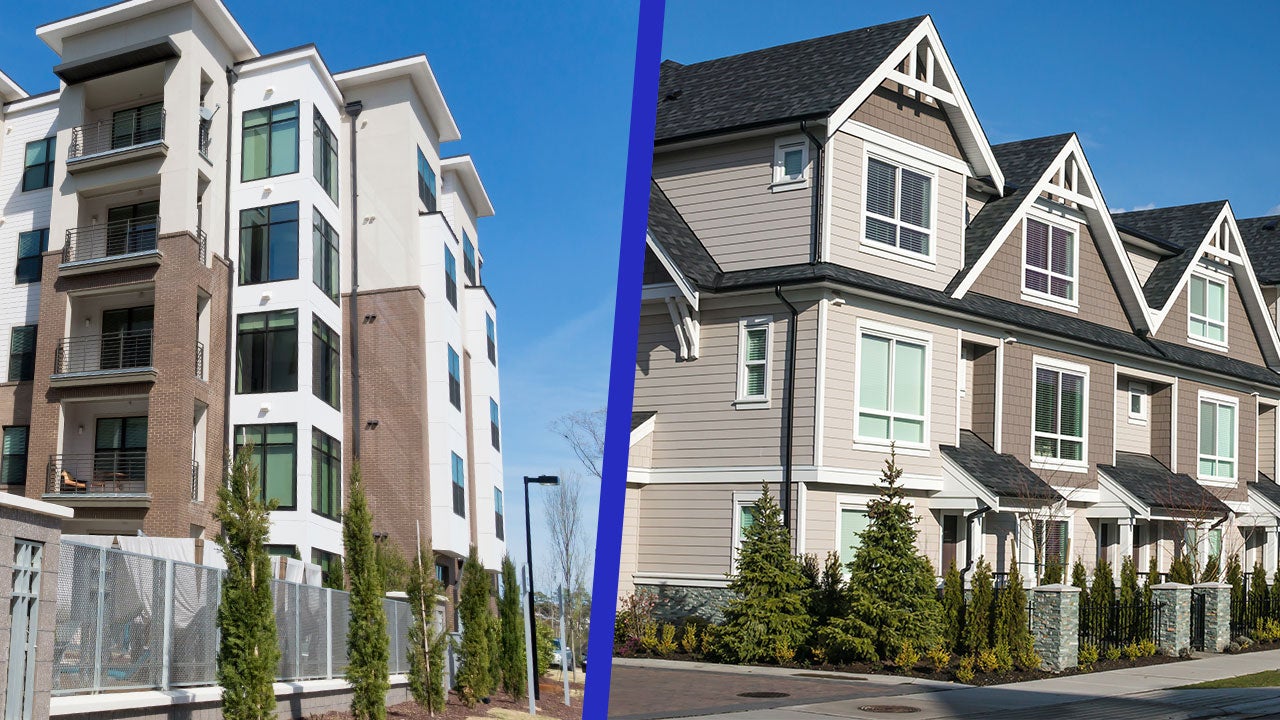Best places to live when you can work from anywhere

In 2022, life began to feel somewhat “normal” again: Audiences are flocking to live shows, concerts and sporting events; airports bustle with travelers; kids are attending school. But one piece of your routine might still look quite different than the pre-pandemic era: Where you’re working.
While many companies have re-opened their offices, it’s not the same old 9-to-5 routine for many workers. The most recent edition of McKinsey’s American Opportunity Survey reveals that over half (58 percent) of U.S. employees have the option to work from home at least one day a week — and 35 percent have the option to work from home five days a week.
It seems like remote work is here to stay — at least in some way, shape or form. Assuming your employer lets you log on from, well, anywhere, this raises a big question: If you can work from anywhere, where should you live?
Best places to live when you can work remotely
Job prospects have been one of the key factors that attract people to major cities, but flexible work arrangements mean that you can ditch the high-priced cost of living in a city like Seattle or Boston for a place that offers more bang for the housing buck. With that in mind, we evaluated metro areas across the country to identify places where your ability to work remotely also gives you the ability to live even better. Here’s what we considered:
- Affordability – We analyzed cost-of-living data to determine where you’ll be able to best stretch your dollars. We also compared median home prices from the fall of 2022 using information from local Realtors associations and Redfin to get a sense of which areas offer affordable opportunities to buy a home. Additionally, we looked at the cheapest cities for renters from Rent.com’s data for anyone who isn’t ready to commit to a long-term living situation in the midst of skyrocketing mortgage rates.
- Wellness – Low-cost living only means something if you can actually make the most of living. We looked at listings from chambers of commerce and from convention and visitors’ bureaus to get a sense of the entertainment and dining options in each of these cities. Outdoor recreation was also a critical factor on our list: If you don’t have to be inside an office or commuting, you may as well spend more of your time outside.
- Safety – If you want to love a city, you need to feel safe. We looked at the most recent statistics of violent crime and property crime from CrimeGrade to get a pulse on safety in each of these places.
- Accessibility – You could move to a remote locale, say, but what if you need to travel for work, need to visit the home office regularly, or have kin scattered around the country? To address this, we looked at cities with airports, and evaluated daily flight service to get an idea of how easy it will be to get from point A to point B.
- Connectivity – If you aren’t going into an office, you’re still going to need to log on. In fact, your Wi-Fi speed can make the difference between getting that next presentation submitted on time – or still waiting for it to upload. So, we looked at data from Allconnect’s most recent connectivity report to get a sense of which areas have more internet providers and lower state rates. Additionally, we looked for opportunities to leave home and work from a cafe or coworking space, including rankings from ToolTester’s best cities for freelancers.
While all of these factors are worth considering if you’re thinking about moving, keep in mind that finding a good place to call home when you don’t have to go to an office is a personal decision — one that involves what’s best for you or your family and your financial future.
1. Des Moines, Iowa
- Affordability: 9 out of 10
- Wellbeing: 8 out of 10
- Safety: 8 out of 10
- Accessibility: 7 out of 10
- Connectivity: 9 out of 10
Des Moines first attracted our attention with its standout performance as the second-best connected city in the country in Allconnect’s Internet Connectivity Report – a signal that you’ll always find the signal you need for downloading that presentation deck or spreadsheet. However, after digging deeper, it’s clear there are plenty of reasons to close that computer screen, power down your mobile device and enjoy more of Iowa’s capital city. From sipping a craft beer at free Friday night art events at the city’s Mainframe Studios to exploring more than 800 miles of trails throughout Central Iowa, Des Moines is a place where you can make the most of never having to spend time commuting to an office.
Like everywhere else in the country, buying a home in Des Moines has been getting more challenging. Median sales prices have increased to $275,000 here, according to data from the Des Moines Area Association of Realtors. If you aren’t looking to buy quite yet, though, Des Moines is a great pick: It’s in Rent.com’s most recent rankings of the top 25 cheapest cities for renters. In fact, the cost of renting here has actually declined by more than 18 percent in the past year.
2. Pittsburgh, Pennsylvania
- Affordability: 9 out of 10
- Wellbeing: 8 out of 10
- Safety: 6 out of 10
- Accessibility: 9 out of 10
- Connectivity: 8 out of 10
Pittsburgh jumps onto our list, thanks in large part to its appearance at the top of Bankrate’s list of the best cities for first-time homebuyers. The median sales price here is $235,000, according to data from Redfin, and while the city might not be near a coast, the convergence of the Allegheny, Ohio and Monongahela Rivers provides a stunning backdrop of beauty.
The Pennsylvania city’s low cost of living still comes with all the entertainment of a major market destination. Between the Steelers, Penguins and Pirates, sports fans have plenty of reasons to cheer. And if a seat at the big game isn’t your thing, the city’s creative spirit runs deep: It features several art museums (including one dedicated to native son Andy Warhol), along with a local orchestra, ballet company and opera company. And when you aren’t inside working on your next assignment for your boss (wherever they may be located), you’ll have plenty of reasons to be outside. Pittsburgh scores very highly on the Trust for Public Land’s rating system: 92 percent of residents live within a 10-minute walk of a park.
3. Rochester, New York
- Affordability: 10 out of 10
- Wellbeing: 6 out of 10
- Safety: 10 out of 10
- Accessibility: 4 out of 10
- Connectivity: 9 out of 10
Choose the cosmopolitan vibe in downtown Rochester, or opt for more quiet living in the surrounding nine-county area that makes up the “greater” portion of this region of upstate New York. Whatever you prefer, Rochester wants you: Its Greater Roc Remote Program, a relocation incentive program for remote workers, offers $10,000 of grants and other inducements for eligible applicants. Plus, if you’re a first-time homebuyer, you might be able to qualify for the city’s generous $3,000 grant program to help with your down payment and closing costs. The winters may be cold here (which impacts our wellbeing score), but the summers on Lake Ontario more than make up for your cold-weather hibernation.
While the incentives helped put Rochester on our radar, the real standout piece of this municipality is the safety. Rochester scores an A on CrimeGrade’s reporting. The main drawback to living here is a much smaller airport, so if you need to travel a lot, Rochester might be a tough hub to call home. However, you can also find plenty of places to feel like you’re on vacation without hopping on a plane: The Finger Lakes region is a short drive.
4. Jacksonville, Florida
- Affordability: 8 out of 10
- Wellbeing: 7 out of 10
- Safety: 8 out of 10
- Accessibility: 7 out of 10
- Connectivity: 9 out of 10
While Jacksonville is the most expensive city on our list to buy a home, it’s important to note that $300,000 – the median sales price in September of 2022 – still feels like a bargain for this kind of access to the seaside. (After all, if you’re going to work from home, why not work from the beach?) If you prefer terra firma, the city offers the largest urban park system in the country with more than 80,000 acres including 400 city parks, seven state parks and three national parks. So, if the outdoors is your thing, Jacksonville just be your place to land — in fact, we’ve deemed it one of the best places to live in Florida, period. Plus, the city earns a solid B- rating from CrimeGrade for safety.
5. Tulsa, Oklahoma
- Affordability: 10 out of 10
- Wellbeing: 6 out of 10
- Safety: 5 out of 10
- Accessibility: 7 out of 10
- Connectivity: 7 out of 10
How does an extra $10,000 sound? If it’s enticing, Tulsa just might be a candidate for your new home. The Tulsa Remote program is designed to make the second-biggest city in Oklahoma a hotbed for those who can work anywhere, with financial assistance to cover relocation expenses, a monthly stipend and a desk at one of the city’s co-working spaces for the next three years. Plenty of people have taken advantage of it, too: The program has welcomed more than 2,000 new residents since launching in 2018 – a date that shows Tulsa was well ahead of the curve in the work-from-home shift.
But here’s the thing: Tulsa seems like a prime place to live even if you don’t get any extra cash. The median sale price in the city was $251,000 as of the end of 2020, according to data from the Greater Tulsa Association of Realtors, and a low cost of living comes with a tall list of things to do. Meet up with other residents at Gathering Place, the city’s expansive riverfront park; enjoy a night out in the Blue Dome Entertainment District, a hub of bars, restaurants and entertainment venues; or, when you have to work, visit one of the city’s many buzzing cafes. Accessibility has improved, too. While plenty of airports have seen service cuts, carriers have expanded service with announcements for new nonstop flights to and from Orlando, Nashville, Chicago and Austin this year.
Best places to live when you can work from anywhere: Honorable Mentions
If you’re a remote worker willing to pick up and go anywhere, here are three other places to keep on your consideration list:
The Shoals, Alabama
This multi-city region in Northwest Alabama doesn’t quite crack the population code to be on our official list. However, The Shoals is giving Tulsa a run for the money — literally. The Remote Shoals program pays new qualifying residents $10,000 to move to the area for their remote-work duties. The smaller towns in this region mean a slower pace of living than you’ll find in denser areas, but you’ll also find lower crime rates, lower housing costs and lower air pollution overall, potentially making it a contender.
Tucson, Arizona
Remote Tucson’s application period may be closed now, but you should definitely keep your eye on the next round from Startup Tucson. The program includes a wide range of benefits – $1,000 in relocation expenses, $1,000 of Airbnb credits, free internet for a year, an introductory membership to a coworking space and much more – for remote workers who move to this Arizona town. And if you don’t have time to wait, Tucson is worth thinking about without any additional financial incentives. It appears on Bankrate’s Best Places to Live in 2022, and it cracks the top 50 of Rent.com’s cheapest cities for renters.
Topeka, Kansas
Kansas City’s neighbor to the west is worth mentioning, due to its impressively low poverty and crime rates, and high affordability quotient (with a median listing price of $175,000, it ranks as one of Bankrate’s cheapest cities to buy a home in). Then there’s the Choose Topeka program. If you’re a remote worker, you can apply to receive up to $5,000 for renting or $10,000 for buying a home in the city – although it’s important to note that 2022 funds have been allocated, so you’ll need to check back for the opening of the 2023 program.
Are that many people actually relocating?
If you can work from anywhere, it doesn’t necessarily mean you’re going to explore somewhere totally new. Instead, the data shows that a lot of people are moving just a few miles away.
“When we asked homebuyers in 2021 what areas they were considering, we saw the most significant growth in buyers changing neighborhoods in the same city – up 3 percent year over year – and changing cities within the same metro – up 2 percent,” Jeff Tucker, senior economist at Zillow, says. “Although working from home is much more prevalent than it was, many buyers may end up seeking out a spot where the occasional commute to downtown is doable once or twice a week in the event their workplace, or a future employer, goes to a hybrid setup.”
Tucker adds that Millennials are currently making major life decisions, and for most of them, that might not mean packing up for a cross-country trip in search of an entirely new lifestyle. Instead, it probably involves thinking about how to manage their family expenses.
“This group is generally looking for what most generations do when buying their first home – something bigger, often in the suburbs, where they can raise a family,” Tucker says. “Obviously, the presence of other family members or friends nearby – within a roughly 30-minute drive for the occasional free daycare – is going to be a driving factor for a lot of these folks. Child care costs are huge in family budgets right now.”
Still, the option of remote work opens up possibilities, especially for new graduates. When you can work from anywhere, traditional job concerns like a region’s local unemployment rate and the presence of major companies become less of a consideration.
Before you move
If you’re ready to take advantage of your work-from-home situation, here are a few key questions to consider before you start packing:
Flexibility might not be forever: Even if your company isn’t requiring you to come into an office now, it doesn’t automatically mean you’re going to stay at home forever. In fact, a recent survey from Resume Builder revealed that 90 percent of companies plan to require workers to come to the office at least part of the time in 2023.
Face-to-face time can be crucial for your career stability: Matt Massucci, founder and managing partner of Chicago-based talent recruiting firm Hirewell, says that the biggest change over the past year has been a slowdown in hiring.
“Unemployment is still low, but there have been more layoffs – especially in the tech world,” Massucci says. “Those tech companies were generally the ones that were ahead of the curve in letting people work from wherever they want.”
While working from home may be a nice benefit, Massucci points out that a lack of face-to-face time can create some trouble if your company needs to reduce headcount. “If a company is doing layoffs and no one has seen you in a year, does that put you at more of a risk?” Massucci asks.
Additionally, Massucci points out that in-person time is often a core part of a company’s culture, which means that more of it translates to more opportunities to climb the ladder.
“You really have to think about where you want to be and what you want to do,” Massucci says. “If you’re perfectly content with being an individual contributor, working remotely is probably okay. If you want to move into leadership, you’re going to be severely limited if you’re not where your company’s headquarters is located. If you’re removed from everyone else, you can be a bit out-of-sight, out-of-mind.”
Renting may be a wise decision: If you do decide to pack up and relocate, it may be wise to avoid planting permanent roots in any new soil.
“Remote workers moving to an entirely new city should probably consider renting in the short term, to make sure they like the region and to get a sense of the neighborhoods they might most like to live in,” Tucker says. “After that, ultimately the buy versus rent decision comes down to a household’s unique needs and long-term goals. If you’re only planning to stay for a short spell of a year or two, renting can be a great option. Longer term, it often makes more sense financially to search out something affordable to buy and build your equity.”
You may also like

Condo vs. townhouse: Which is best for you?

Best places to live in Arizona in 2023




